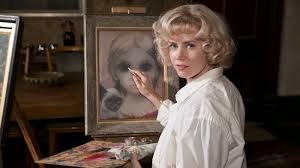Maybe Jack
Skellington’s large, empty eyes were Tim Burton’s way of not allowing anyone to
see into his soul. (We did anyway!) In Big
Eyes, Burton’s most recent work of art, we are invited to dive into those
big, sorrowful eyes; not the ones that Margaret Keane painted on her waif-like
children, but those of the artist herself, her soul, remarkably well portrayed here
by Amy Adams at her best.
Tim Burton has
outdone himself in this film. The film concentrates many aspects of the creative
style he has been building over the years, like his use of colors, for example.
Burton’s films are always marvelously colorful, whether he is using pastels,
like he does here or in Edward
Scissorhands, or dark hues, like in Batman,
Dark Shadows or even Alice in Wonderland. His camera angles
are another example of his skill. There is a little bit of Hitchcock, a little Wes
Anderson, but a lot of just Tim Burton, his close-ups, his landscapes, his so
very carefully crafted sets where there is so much movement, so much to see in
each shot! The screen is truly a canvas for this director and there is never a
wasted moment of film. It is still Tim Burton and Wes Anderson that keep
American cinema in the forefront of creativity and give the audience so much
more than just a story.
But even in the
choice of the story we find Tim Burton’s style. Once again, as
in Ed Wood, here is an artist with a
rather obscure place in art history. Were Keane’s paintings art? Were Ed Wood’s
films? Who defines what art is and how is it determined? What about popularity and art, "mass" art? All touched upon here, but this time Burton not only dives into the art
of Margaret Keane and has his eyes on her soul, but he also impressively
presents the dynamics of her relationship with Walter Keane, the husband that
passed her art off as his and dominated her almost to the point of destruction.
 |
| Christoph Waltz and Amy Adams |
The plot, then,
is not just about Keane and her art, it is about a woman confined, dominated,
as women were (and too many still are), trapped in a relationship that is
slowly sucking the life out of her. Burton is brilliant at capturing the feeling
of suffocation, of despair that Keane suffers. With the talent of Christoph
Waltz, who plays Walter Keane, we also witness the undoing of the domineering
man; as women begin to take control of their lives, the men who dominate them also
see their senseless world begin to crumble. We witness their ridiculousness, their smallness. The movie is a feminist statement
in this way and more. For many women, it is a roller coaster of emotions and we
are never removed from the characters on the screen.
I am surprised
that many critics haven’t seen a lot of what I’m pointing out in a film that
I consider one of the most complete films of the year. Again, maybe it is
because a lot of movie critics are male, very mainstream and safe within their
privilege. (The same ones that found Keanu Reave’s macho movie John Wick so compelling!) Burton’s
humanity sheds so much of his male privilege and he is able to see into the
soul of women dominated. Because he has looked into the world of the “outsider”, of those on the margins of society so many times in his films, he is able to takes us along as he looks into
the souls of his characters, making us all the more humane in the process.
 |
| Director Tim Burton |

Thanks for your interesting post. The world today needs more reflections on gender equality Keep writting and all the best for 2015 and movies!!!
ReplyDelete